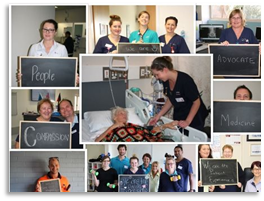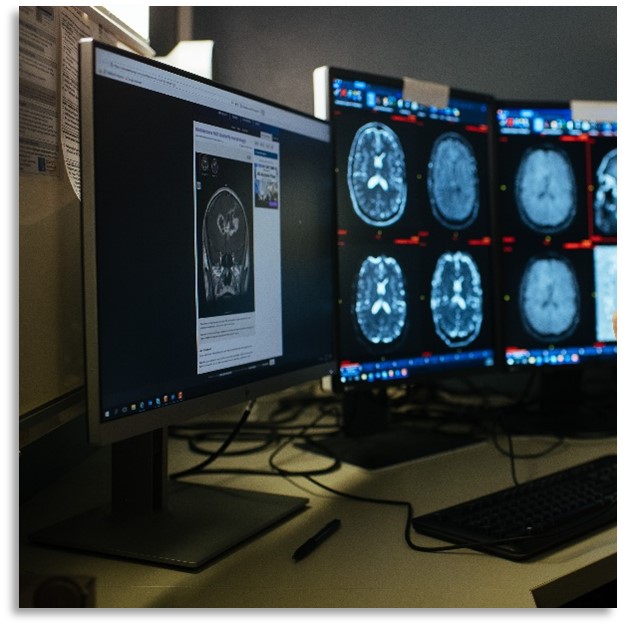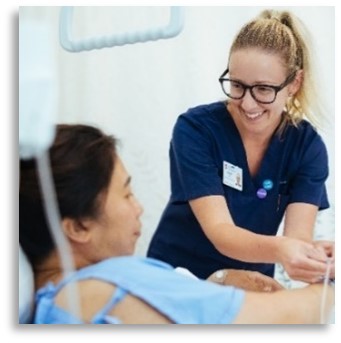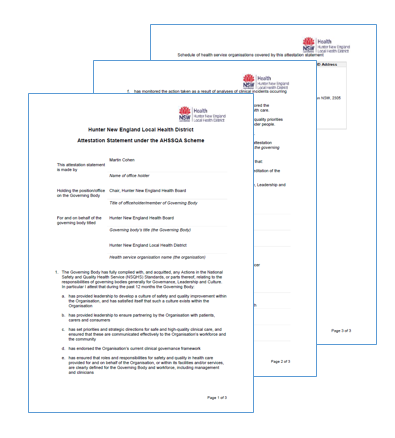Review of Performance and Future Safety & Quality Priorities
NSW Health has identified five State Outcomes that cover the range of functions and services provided across healthcare settings. The Outcomes are described in detail in the NSW Health Outcome and Business Plan.
This section reports HNELHD’s performance for the 2022-23 financial year on a range of performance measures that align with the State Outcomes. Related initiatives and actions are also presented, highlighting the efforts the district is making to continually improve our services.
NSW Health Outcome 1: Keeping people healthy through prevention and health promotion
This outcome reflects that preventive and population health measures are critical to keeping people healthier. It covers a range of functions including to promote public health, control infectious diseases, reduce preventive diseases and death, help people manage their own health including mental health, and promote equitable health outcomes in the community.
With more than one in five children in NSW being obese or overweight, the NSW Ministry of Health have made reducing obesity a priority. Programs and resources are available to help with prevention and intervention for childhood obesity. A variety of resources and guidelines are available to support measuring height and weight for all children. The resources provide a guide to:
- Measuring height and weight
- Having conversations with parents of children who are above healthy weight
- Making referrals to programs aimed at helping children who are above a healthy weight such as Go4Fun
27.7% of pregnant women who smoke quit smoking during the second half of pregnancy.
Health checks provide families with access to essential services and early intervention where required, optimising the child’s developmental outcomes. The 1-4 week health check is the first of a schedule of these checks offered by NSW Health services as part of the First 2000 Days Framework.
During 2022-23, HNELHD Child and Family Health Nurses conduct 1-4 week checks across 49 different clinic locations. The services work to engage families and provide a seamless transition from maternity to child and family health services.
95.1% of children in HNELHD are fully immunised at one year of age.
BreastScreen participation rates:
- 55.3% of women aged 50-69 years
- 58.7% of women aged 70-74 years
Hepatitis C is a liver infection that has serious health outcomes, including liver cancer, if left untreated. Available research suggests that the rate of hepatitis C in people admitted to mental health units is up to fifteen times higher than the general population, and that the rate of testing and treatment is lower.
With funding assistance from NSW Ministry of Health, HNELHD are running a pilot project aimed at improving access to hepatitis C testing and treatment for people admitted to mental health units. The project supports patients to access testing and commence treatment during their admission, and puts supports in place to aid the completion of treatment after discharge. The project has developed training resources for staff, education materials for patients, trialled new testing and treatment methods and is collecting clinical data and patient/staff feedback to measure the success of the project.
NSW Health Outcome 2: People can access care in out of hospital settings to manage their health and wellbeing
Healthcare extends beyond the hospital and connects across settings to reduce the burden of chronic disease, assist people with conditions to live well and avoid complications, support people to recover from illness and injury, and prevent avoidable hospitalisations. NSW Health services include non-admitted and community-based services, subacute services, hospital in the home, and dental services.
80.5% of families enrolled in the Sustaining NSW Families Programs are continuing in the program.
65.7% of enrolled families completed the program by the time the child reached 2 years of age.
Domestic and family violence (DFV) involves enormous personal harm, impairs children's health and development, and incurs substantial social and economic cost to society. As emergency departments (EDs) are often the first point of contact with the health system for victims of DFV, it is important that victims are identified and supported whenever they present to any ED across the District. Screening was prevented for 36% of patients due to the presence of another person.
HNELHD Violence Abuse and Neglect Services have designed an ED model of care that is available 24/7 for victims of DFV. The model was trialled at Tamworth ED and included identification and support for victims of DFV in the ED, timely psychosocial crisis response, and referral for follow up. The service is now focussed on expansion to other facilities within the district.
21.9% of non-admitted services were provided through telehealth.
There has been continued growth in the use of telehealth by many services across the District. myVirtualCare, the state-wide telehealth system supported by eHealth, has become part of regular activities for many HNELHD services. Examples of services that have started using or expanded their use of myVirtualCare include:
- COVID Care in the Home
- Interpreter services
- virtualKIDS, reducing the time children and their families wait in the Emergency Department at John Hunter Children’s Hospital.
- Emergency Mental Health reviews to 26 emergency departments across the District
- Group education sessions including psychotherapy, pain management, parenting education classes and cardiopulmonary rehabilitation.
82.6% of the discharge summaries completed for inpatient stays were received electronically by General Practitioners
13.6% of patients discharged from acute mental health services are readmitted within 28 days of discharge.
Across the District there was a full-time equivalent of 18.5 Mental Health Peer workers employed as of June 2023.
After discharge from mental health facilities, 73.2% of patients received follow-up community care within 7 days.
Readmission following discharge from a mental health unit can occur for many different reasons. The HNELHD Mental Health Service is aiming to reduce readmission rates for Aboriginal people through a number of approaches, one of which is the employment of the Aboriginal Mental Health and Social and Emotional Wellbeing Care Navigator.
The Care Navigator supports clinical teams in the development of culturally informed assessment, treatment approaches, and discharge planning. They work to ensure that social, cultural and historical contexts are at the forefront of services offered through mental health services. The Care Navigator works to establish systems, services and processes between mental health and other services. These linkages promote collaboration between services, reduce duplication and ensure appropriate support at transitional points in care for Aboriginal people.
Working alongside the Care Navigator is the Peer Worker. The Aboriginal Mental Health and Social and Emotional Wellbeing Peer Worker delivers immediate support and compassionate care with the insight and understanding of a person who has lived experience of a mental illness. The Peer Worker is also a source of information about other community-based services such as housing support, relationship counselling and financial assistance.
NSW Health Outcome 3: People receive timely emergency care
The emergency department is often the first point of contact for people needing urgent healthcare. The measures below reflect the capacity of health services to transfer patients from ambulances to the emergency department, to see emergency patients, and to move patients who need admission to wards in a timely manner.
20% of patients presenting to emergency department (ED) who require admission had a total time in ED of less than 4 hours.
The percentage of people who presented to ED who were treated within the clinically recommended timeframe was:
- 100% Triage 1 (seen within 2 minutes)
- 76.7% Triage 2 (seen within 10 minutes)
- 67.8% Triage 3 (seen within 30 minutes)
78.3% of patients were transferred from ambulance to ED within 30 minutes
HNELHD is focussing on the whole of Hospital Project that is prioritising escalation of Emergency Department bed block and developing strategies to overcome this by using short term escalation plans. An Emergency Department flow coordination tool, known as the ED Whiteboard, has also been updated to assist with processes and flow to meet ETP.
Our rural and regional sites are now using a virtual care model, facilitated by my ED doctor. An evaluation of this program has been conducted and areas of improvement have been identified. HNELHD is now working with the vendor to reduce wait times for our rural communities.
HNELHD is collaborating with the MoH on triage accuracy and compliance with the Australasian Triage Scale. This has been further enhanced by the Emergency streams renewed focus on quality and standardisation of education given to Triage nurses, district wide.
HNELHD is piloting a CADlink system in addition to an increase in Ambulance stations. This involves review of all short-term escalation plans for offloading ambulances and patient flow through ED using a district wide approach. This system has helped the LHD identify gaps within the systems and processes that have been prioritised to improve our performance.
There were 156 instances where patients with mental health presentations stayed in emergency departments longer than 24 hours.
HNELHD is collaborating with NSW Ambulance and NSW Police on the Mental Health First Responder service. This initiative provides Police and Ambulance officers with priority access to specialised mental health triage services via telehealth for people experiencing mental health concerns. The triage is a brief mental health intervention which helps to identify the most appropriate type of care for the person that has led to 85% of patients referred to stay at home. The mental health clinician and the Police or Ambulance on scene work together following triage to connect the person with the right level of care to meet their needs, which may involve:
- follow-up by community mental health
- community-based supports such as GP or other relevant services
- transportation to hospital for mental health assessment
NSW Health Outcome 4: People receive high-quality, safe care in our hospitals
This outcome reflects the state’s responsibility to manage and administer public hospitals. When people are admitted to a hospital in New South Wales, they can expect world-class medical and surgical care within clinically recommended timeframes, with NSW Health operating the largest public hospital system in Australia.
Between July 2021 and June 2022, the percentage of patients who had their surgery within the recommended timeframe was:
- Category 1 - 99.6%
- Category 2 - 83.5%
- Category 3 - 94%
The number of patients waiting for elective surgery beyond the recommended timeframe as at June 2022 was:
- Category 1 - 0
- Category 2 - 304
- Category 3 - 618
HNE have struggled to return to pre- covid surgical activity levels, primarily due to workforce gaps, and inpatient activity using many of the available beds that would generally be used for surgery.
All sites are actively working to recruit surgical/ anaesthetic staff to enable surgery to occur, whilst also working on reducing length of stay.
HNELHD has purchased a certified medical 3D printer based at the Hunter Innovation Living Lab (HILL), which has now been implemented at the John Hunter campus with an accompanying policy framework.
3D printing is being used in an increasing number of clinical areas, and the ability to produce items locally has enabled clinicians and engineers to collaborate directly and reduce turnaround times. The 3D printer can produce anatomical models to support patient diagnosis and assist surgeons to plan for complicated surgery. 3D printed models are also being used to enhance simulation training for clinicians.
Hospital-acquired complications
Hospital-acquired complications cover a wide range of conditions that can occur during a patient’s admission, and that may have been preventable. The rate of hospital-acquired complications is monitored in all NSW hospitals as a measure of the safety and quality of care.
Between 1 July 2022 and 30 June 2023, 97.8% of hospital admissions across HNELHD were free of hospital-acquired complications. The table below shows the rate of hospital-acquired complications per 10,000 “episodes of care,” and some of the strategies in place to further reduce their occurrence.
- hospital acquired pressure injuries - 4.72 per 10,000 episodes of care
- fall-related injuries-resulting in fracture or head injury - 5.08 per 10,000 episodes of care
- healthcare associated infections - 108.55 per 10,000 episodes of care
- hospital acquired respiratory complications - 31.82 per 10,000 episodes of care
- hospital acquired blood clots - 7.71 per 10,000 episodes of care
- hospital acquired renal failure - 0.55 per 10,000 episodes of care
- hospital acquired gastrointestinal bleeding - 8.55 per 10,000 episodes of care
- hospital acquired medication complications - 8.43 per 10,000 episodes of care
- hospital acquired delirium - 36.42 per 10,000 episodes of care
- hospital acquired incontinence - 2.39 per 10,000 episodes of care
- hospital acquired endocrine complications - 22.83 per 10,000 episodes of care
- hospital acquired cardiac complications - 37.86 per 10,000 episodes of care
- hospital acquired 3rd or 4th degree perineal lacerations - 389.29 per 10,000 episodes of care
- hospital acquired neonatal birth trauma - 56.25 per 10,000 episodes of care
Rates of HACs vary over time and between hospitals. This can be due to seasonal influences such as the winter flu season, caseload differences where a hospital specialises in a particular type of care, or it could be due to differences in the care provided.
HNELHD has 25 hospitals, and no two hospitals are the same. It is important to be able to differentiate warranted variation from unwarranted variation in patient care. HNELHD is committed to minimising unwarranted clinical variation and identified the development and implementation of the Clinical Variation Framework as a priority in last year’s Safety and Quality Account.
The Clinical Variation Framework was released December 2021, accompanied by a suite of tools and resources to assist clinical teams identify and assess instances of unwarranted clinical variation. The resources that have been developed align with published standards such as Clinical Care Standards, Leading Better Value Care, and Hospital Acquired Complications definitions.
Where an HNELHD hospital has a HAC rate that varies from the predicted rate, the Framework provides guidance and tools to assess whether the variation is warranted or unwarranted. Where unwarranted variation is identified, actions to reduce the risk of HACs occurring are initiated and updates on progress are provided to the relevant Clinical Quality and Patient Care Committee.
The rate of admitted Aboriginal patients who discharged against medical advice was 1.3%
The rate of unplanned hospital readmission within 28 days of discharge was:
- 4.2% for Aboriginal patients
- 4.6% for all patients
Patient Survey Results
Patient experience index - patients’ ratings of staff teamwork, organisation of care, and overall rating of care.
- Adult admitted patients – 8.7/10
- Emergency department patients – 8.3/10
Patient engagement index - a measure of information provision and involvement in decisions about care.
- Adult admitted patients – 8.5/10
- Emergency department patients – 7.8/10
Emergency departments across HNELHD are implementing the strategies of NSW Health’s Emergency Department Patient Experience initiative. The initiative aims to create an environment that makes patients, carers and their families feel welcomed, safe, cared-for and empowered.
In addition to waiting room enhancements such as mobile phone charging stations, Patient Experience Officers are employed in nine of the District’s emergency departments during peak demand times. Patient Experience Officers help make sure that people presenting to emergency are oriented to the amenities of the department, and act as a link between consumers and the clinical operations of the department. They also help collect patient feedback via an online survey.
Patient survey feedback is taken into consideration when planning changes to waiting rooms and other parts of the departments. The emergency department is a fast paced and often stressful workplace. With over 80 percent of survey responses being positive, the patient survey is a welcome source of reinforcement and encouragement for the emergency department staff.
74% of mental health consumers rated their care in HNELHD as very good to excellent.
HNELHD Mental Health Services continue to monitor and report on consumer engagement through the Clinical Quality and Patient Care Committee monthly. Peer workers are engaged daily to assist in identifying barriers and blockages to care and patient satisfaction.
Seclusion occurred in 5.6% of admitted acute mental health stays.
There were 6.9 episodes of seclusion per 1,000 bed-days in acute mental health units.
The average duration of each acute seclusion episode was 2.94 hours.
Building Positive Safety Cultures is currently being implemented as this is an identified priority for HNELHD Mental Health Services. This program aims to reduce restrictive and coercive practices within care.
HNELHD continues to progress implementation of Safewards across all inpatient mental health facilities. The objective of the Safewards model is to reduce conflict and the use of containment within mental health services, improving the safety of patients, staff, and visitors.
Implementation of Safewards strategies involves significant planning, staff training and consumer engagement. Units within HNELHD Mental Health Services have implemented of the Safewards strategies as a part of the Building Positive Safety Cultures program.
For every 1,000 bed-days in mental health inpatient units, 1.4 involuntary patients abscond.
Modern, purpose-built facilities support the provision of best practise mental health services. Several mental units within the district have previously undergone redevelopment and improvements.
Tamworth Mental Health Inpatient is currently undergoing redevelopment to align with current building standards for acute mental health inpatient units to reduce the risk of category 1 absconding patients.
This is also reported on monthly through the Clinical Quality and Patient Care Committee and Patient Safety Report.
NSW Health Outcome 5: Our people and systems are continuously improving to deliver the best health outcomes and experiences
A skilled workforce with access to world-leading education and training, and a system that harnesses research and digital innovation is essential to continuously improve outcomes and experiences of care across the system.
NSW Public Service Commission People Matter Employee Survey (PMES)
36% of staff believe the culture at their workplace has improved over the past 12 months (3.0% less than 2019).
30% of staff were confident that the organisation will act on the results of the People Matter Survey (3.0% less than 2019).
8% of Aboriginal staff and staff who speak a language other than English at home reported experiencing racism at work.
PMES results specific to individual services are presented by local management teams to their individual services at each level of the organisation. Survey action groups are formed within each service that include a representation from all the smaller teams and disciplines that sit within the service. The action groups lead the development of local action plans to address PMES feedback. Action plans are shared with staff and updates are incorporated into accountability tools of the Excellence framework to close the loop to staff regarding actions taken as a result of PMES results.
HNELHD strives to deliver Excellence to every patient, every time. Excellence is delivering the best possible care to each patient, in a safe, healthy and culturally sensitive environment. The principles of Excellence are implemented in HNELHD via many practises and tools including Leader Rounding with staff, Standards of Behaviour, and accountability processes such as Monthly Accountability Meetings and 90 Day Action Plans.
Staff Engagement in the People Matter Survey was 18% more than the previous survey.
Staff performance reviews are collaborative and structured discussions, allowing employees and their managers to recognise achievements, provide feedback regarding performance, and explore other developmental opportunities within the organisation for the employee.
This year HNELHD Hunter Valley Sector (encompassing areas including Denman, Merriwa, Murrurundi, Muswellbrook, Scone, Singleton,) achieved a 35% increase in the completion of performance reviews. The Sector employed multiple strategies, such as tabling performance review performance at management meetings and increased frequency of reporting, making performance reviews a part of business as usual.
5.5% of HNELHD’s total workforce identify as Aboriginal.
It takes an average of 5 business days to approve, decline, or defer recruitment once a request is made.
HNELHD continues to improve workplace safety and embed safety culture across the District. Strategies include the We’re Safe Calendar, which establishes a District wide safety focus each month, providing discussion prompts and activities for use at team meetings.
Priority areas for the Work Health and Safety team continue to be the three main occupational hazards in healthcare:- Manual handling
- Violence and aggression
- Slips, trips and falls
HNELHD is committed to developing a culture where all staff feel empowered to raise occupational health and safety issues in their workplace.
99.15% of human research ethics applications (involving more than low risk to participants) approved within 90 calendar days.
95.3% of site-specific research governance applications were authorised within 60 calendar days.
HNELHD Safety and Quality Priorities
Closing the Loop on Last Year's Priorities
Five priority initiatives were identified in last year's HNELHD Safety and Quality Account. The following section lists each priority and provides a brief update:
24/7 Domestic Family Violence (DFV) response service
The DFV response service trialled an after-hours crisis psychosocial response to Violence Abuse and Neglect (VAN) presentations in a Rural and Regional Emergency Department by expanding the existing crisis sexual assault workforce. The 6-month trial involved a full out-of-hours psychosocial crisis service for people presenting with DFV or child protection issues. Key outcomes included 37 referral calls, 5 admissions, and positive feedback from the VAN Crisis workforce and key stakeholders.
Recommendations include making the VAN Crisis Service an ongoing model and scaling it to other facilities across the district.
Aboriginal Cultural Supervision Yarning program
HNELHD has active participation in the Aboriginal Cultural Supervision Yarning Program. The program supports the provision of cultural supervision to HNE’s Aboriginal workforce by matching the with trained Cultural Supervisors and connecting with individuals and groups aiding safe yarning about learning and development pathways, problem solving and reflective practices that influence quality patient care and improved health outcomes for Aboriginal peoples and communities. The program aims to increase the number of supervisors to meet the Aboriginal workforce demand with an online learning model and is designed to be accessible to non-Aboriginal managers and leaders to enhance cultural understandings. The program will be integrated into our recruitment processes specific to Aboriginal peoples defining the supports available from the organisation.
The HNEkids Compass Project
The HNEkids Compass Project aims to improve care coordination for Children with Medical Complexity (CMC) and their families. These children need access to many health services and professionals due to chronic health problems. The project team has developed the HNEkids Complex Care Coordination Service. This includes an intensive 6-month dose of care coordination provided by a dedicated coordinator, followed by ongoing support from a district wide network of paediatric health staff. A family-centred approach is central to the service, which began accepting referrals in June 2023. Its focus is identifying goals, streamlining appointments, and improving communication across care teams. The project aims to improve efficiency. It will be continuously monitored and improved based on feedback from CMC, families, and staff involved. For more information see Achievements (insert Hyperlink)
Expansion of Services to support consumers in the last two years of life
Supportive Care for Chronic Disease is a service that provides care to patients and caregivers in the last two years of life, alongside standard care in outpatient and community settings. The service focuses on supporting individuals with advanced chronic diseases such as heart failure, liver disease, motor neurone disease, movement disorders, and Aboriginal people within the Integrated Chronic Care for Aboriginal People Program (ICCAPP). To improve access, SCCD uses a virtual care model, giving consumers have more options for how they attend appointments. The service is expanding and currently recruiting additional clinicians, including a Speech Pathologist, Occupational Therapist, and a palliative care physician. Their main objectives now include delivering clinical care and enhancing the capabilities of chronic disease clinical teams.
The Mental Health First Responder program
The Mental Health First Responder (MHFR) program in NSW uses iPads to connect emergency services with specialized mental health triage services. This collaboration with the HNE Mental Health Network improves care for people in contact with police and ambulance. Recommendations from the triage service may include hospital transportation, community mental health follow-up, or support from GPs or community-based resources. The program's success has led to 85% of referred individuals being able to stay at home, reducing unnecessary hospital visits and pressure on emergency resources. MHFR is expanding across rural and regional areas, providing broader access to mental health triage for those in contact with emergency services. For more information, see “Improvements Achieved through Priority Initiatives”
Safety and Quality Priorities for 2023-24
The following list highlights some of the safety and quality priorities that are being implemented over the coming year. These and other actions are described in the 2023/24 Hunter New England Local Health District Operational Plan and/or the Strategic Plan 2021 to 2026.

Voluntary Assisted Dying Model of care and Hospital HealthPathways (End of Life)
In 2022 the Voluntary Assisted Dying Act 2022 was passed by the NSW parliament. The Act will allow eligible people the choice to access voluntary assisted dying in NSW from 28 November 2023.Voluntary assisted dying means an eligible person can ask for medical help to end their life. The person must be in the late stages of an advanced disease, illness, or medical condition. They must also be experiencing suffering they find unbearable. HNELHD is preparing for voluntary assisted dying to become available within our district. This includes the establishment of a model of care and a Hospital HealthPathway to support clinicians and consumers during this difficult time.

Excellence – Building on our success (Excellence: Back to Basics)
At HNELHD we are committed to Excellence to every patient, every time. Excellence is delivering the best possible care to each patient, in a safe and compassionate environment. Nursing & Midwifery Services are building on the success of the program by enhancing aspects throughout the district including our Patient Care Essentials. The team is also working on building support for the development of our Leadership teams through the “Manager Essentials” resources, providing the skills, knowledge, and support to increase capability and enhance capacity for our leadership teams.

Strategic Framework to Improve Aboriginal Health and Wellbeing
The Strategic Framework to Improve Aboriginal Health and Wellbeing (SIAH) is a continuation of HNELHD’s (HNE) Closing the Gap (CTG) journey. The SIAH Framework is embedded within HNE Health’s Strategic Plan 2021-26 and aligns closely to HNE Health’s CTG Strategic Plan 2020 Review Report and the National Closing the Gap Reform. Within the SIAH Framework are five foundational principles to apply an Aboriginal cultural lens to how HNE Health services engage, design, and deliver their services to meet the needs of Aboriginal people, consumers, and staff. The SIAH Framework shifts the focus from a deficit ‘gap’ model to one that embraces and celebrates the strengths and resilience of the world’s oldest, continued culture.

Single Digital Patient Record
Clinical information is captured in many different systems across NSW Health. Currently, clinicians must access multiple platforms to get a full patient history. HNELHD is working with eHealth and Pathology NSW as the lead Local Health District on the new Single Digital Patient Record (SDPR). Th SDPR will enable clinicians to have fast, secure, and easy state-wide access to an integrated record of an individual’s medical history. These records will also be available in real-time, no matter where patients seek treatment. This will improve the coordination, continuity, and experience of care for patients and contribute to positive patient health outcomes.

Partnering with Consumers – HNE LHD Consumer Engagement and Framework Strategy 2023-2026
The Hunter New England Local Health District Partnering with Consumers Committee (DPCC) identified in late 2022 the opportunity to develop a resource to support clinicians and clinical teams with Consumer engagement; what is Consumer engagement, why is it important and how do we engage Consumers. Consumer engagement is about health services working with consumers and carers as equal partners in their own care. This approach delivers better health outcomes, improves patient safety and quality of care, and fosters person and family centred care. The first draft is now available, and we are preparing to facilitate a Focus Group with Consumers to gain their thoughts and perspectives about our goals, the guiding principles and what engagement would look like for them.
Attestation Statement

All Australian health service organisations are required to submit an annual attestation statement to their accrediting agency. The attestation statement is a formal document stating that the District is complying with safety and quality and clinical governance processes as set out within the NSQHS Standards.
The Attestation Statement can be downloaded by clicking on the image to the right:
Previous Safety & Quality Accounts
The Hunter New England Local Health District Safety & Quality Account is updated each year. For previous versions of the Safety & Quality Account, please follow the link below.

